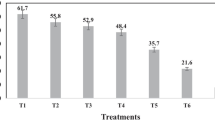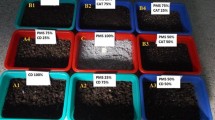Abstract
Textile mill waste can be vermicomposted if it is mixed in the range of 20–30% with cow dung. This article reports the effect of inoculation, of nitrogen fixing Azotobacter chroococcum strain; Azospirillum brasilense strain and phosphate solubilizing Pseudomonas maltophila, on nitrogen and phosphorus content of vermicomposts prepared from cow dung (CD) and cow dung spiked textile mill sludge (CD + STMS). The CD vermicompost was more supportive to the growth and multiplication of all the three bacteria than CD + STMS vermicompost. In Azotobacter chroococcum treated vermicomposts maximum nitrogen content was recorded between 45 and 60 days [CD␣vermicompost (25.9 ± 0.45 g kg−1) and CD + STMS vermicompost (20.6 ± 0.62 g kg−1)] followed by Azospirillum brasilense inoculation [CD vermicompost (19.4 ± 0.60 g kg−1) and CD + STMS vermicompost (18.6 ± 0.17 g kg−1)]. Phosphorus content in Pseudomonas maltophila inoculated CD vermicompost was 20.8 ± 0.20 g kg−1 and CD + STMS vermicompost was 13.4 ± 0.45 g kg−1 after 75th day of inoculation.
Similar content being viewed by others
References
Butt, K. R. (1993). Utilization of solid paper mill sludge and spent brewery yeast as a feed for soil-dwelling earthworms. Bioresource Technology, 44, 105–107.
Edwards, C. A., & Lofty, J. R. (1977). Biology of earthworms (2nd ed., Vol. 9, p. 333). London: Chapman and Hall.
Elvira, C., Goicoechea, M., Sampdro, L., Mato, S., & Nogales, R. (1996). Bioconversion of solid paper-pulp mill sludge by earthworms. Bioresource Technology, 75, 173–177.
Elvira, C., Sampedro, L., Benitez, E., & Nogales, R. (1998). Vermicomposting of sludges from paper mill and dairy industries with Eisenia andrei: A pilot scale study. Bioresource Technology, 63, 205–211.
Garg, V. K., & Kaushik, P. (2005). Vermistabilization of textile mill sludge spiked with poultry droppings by an epigeic earthworm Eisenia foetida. Bioresource Technology, 96, 1189–1193.
Jensen, V. (1951). Notes on the biology of Azotobacter. Proceedings of the Society for Applied Bacteriology, 74, 93–98.
Kale, R. (1991). Vermiculture: Scope for new biotechnology. Calcutta: Zoological Survey of India.
Kale, R. D., Mallesh, Bano, K., & Bagyaraj, D. J. (1992). Influence of vermicompost application on the available macro nutrients and selected microbial population in a paddy field. Soil Biology and Biochemistry, 24, 1317-1320.
Kaushik, P., Garg, V. K. (2003). Vermicomposting of mixed solid textile mill sludge and cow dung with epigeic earthworm Eisenia foetida. Bioresource Technology, 90, 311–316.
Kaushik, P., & Garg, V. K. (2004). Dynamics of biological and chemical parameters during vermicomposting of solid textile mill sludge mixed with cow dung and agricultural residues. Bioresource Technoogy., 94, 203–209.
Okon, Y., Albrecht, S. L., & Buriss, R. H. (1977). Methods for growing Sprillum lipoferum and for counting it in pure culture and in association with plants. Applied and Environmental Microbiology, 33, 85–88.
Parle, J. N. (1963). A microbiological study of earthworm cast. Journal of General Microbiology, 31, 13–22.
Pikovskaya, R. E. (1948). Mobilisation of phosphorus in soil in connection with vital activity of some microbial species. Microbiologia, 17, 362–370.
Premono, E.-M., Moawad, M. A., & Vlek, P. L.G. (1999). Effect of␣phosphate solubilizing Pseudomonas putida on the growth of maize and its survival in the rhizosphere. Indonesian Journal of Crop Science, 11, 13–23.
Satchell, J. E., & Martin, K. (1984). Phosphate activity in earthworm faeces. Soil Biology and Biochemistry, 16, 191–194.
Sherman-Huntoon, R. (2000). Latest developments in mid-to-large-scale vermicomposting. Biocycle, 41(11), 51–54.
Sinha, R. K., Heart, S., Agarwal, S., Asadi, R., & Carretero, E. (2002). Vermiculture and waste management: study of action of earthworms Eisenia foetida, Eudrilus euginae and Parionyx excavatus on biodegradation of some community wastes in India and Australia. The Environmentalist, 22, 261–268.
Suthar, S. (2006). Potential utilization of guar gum industrial waste in␣vermicompost production. Bioresource Technology, 97, 2474–2477.
Tiwari, S. C., & Mishra, R. R. (1993). Fungal abundance and diversity in earthworm cast and in uningested soil. Biology and Fertility of Soils, 16, 131–134.
Author information
Authors and Affiliations
Corresponding author
Rights and permissions
About this article
Cite this article
Kaushik, P., Yadav, Y.K., Dilbaghi, N. et al. Enrichment of vermicomposts prepared from cow dung spiked solid textile mill sludge using nitrogen fixing and phosphate solubilizing bacteria. Environmentalist 28, 283–287 (2008). https://doi.org/10.1007/s10669-007-9141-5
Received:
Accepted:
Published:
Issue Date:
DOI: https://doi.org/10.1007/s10669-007-9141-5




